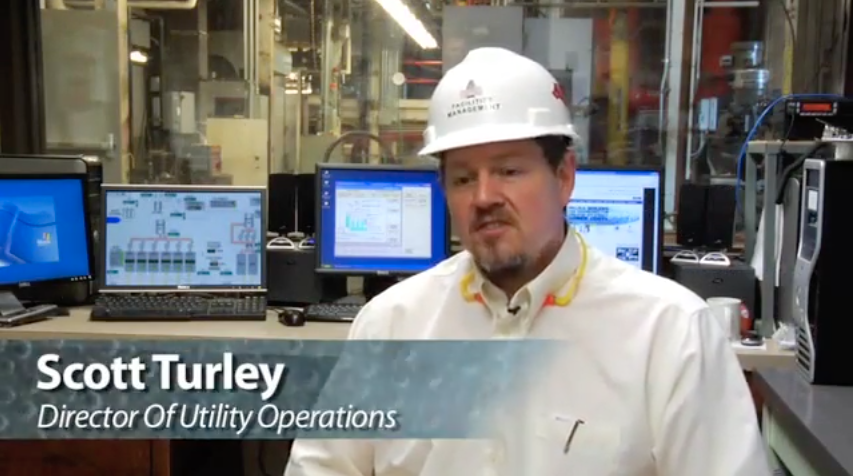TRANSCRIPT: Recent upgrades to the steam boiler plant at the University of Arkansas's Fayetteville campus are a good example of how institutions can optimize their thermal energy usage by leveraging multiple factors. These factors include the integration of on-demand steam technologies into existing systems, utilization of best practices and operations and maintenance, energy benchmarking, and even creative financing of energy upgrades via a performance contracting agreement. The upgrades at the university's steam plant also showcase the important role each of the factors plays in reducing the carbon footprint of a major university campus.
Scott Turley: My name is Scott Turley. I'm Director of Utility Operations.
Paul Brewer: My name is Paul Brewer. I was the project manager on the job.
Doug Moore: I'm Doug Moore. I'm the plant engineer. I'm over the operations of the heating plant and chilled water plant.
Scott Turley: Here at the University of Arkansas, utility operations is responsible for steam production, heating hot water production, chilled water production, primary electrical distribution on campus, and we also do building controls.
Paul Brewer: Initial design of the job was to replace three existing Kewanee boilers that were out of service with one new boiler.
Scott Turley: Just because of age and efficiency they had kind of fallen out of use and needed to be replaced.
Paul Brewer: The decision to go to the Miura boilers was made after the initial award of the contract because of the higher efficiency of the Miura boilers.
Scott Turley: We went through a competitive selection process. Johnson Controls was selected to be our partner. As we started engineering the project together, it was a design-build project. We had found out about the Miura boiler technology through our local rep out of Memphis, Tennessee and introduced us to the product. It looked good to us, looked like a good fit for what we were trying to do and just started doing our research and thought it was the right choice for the project.
Doug Moore: I came into the project in December of '07 when I was hired on. The boilers came on in March of '08, so it was toward the very end of the project.
Paul Brewer: We were able to use the footprint of two of the existing boilers to put all six of the new Miuras. Three Miuras then would take the footprint of one of the old existing boilers. That left us with one bay open which the university utilized to put in some emergency generators in that spot.
Scott Turley: Part of the project that we did was to put in a centrifugal heat pump, so it's an electric technology. That system is providing about 20,000 MBH of heat. If we want to turn it down, turn it off for demand shedding we needed a technology that would respond very quickly that we could spool up in a hurry. The Miura boilers fit that application very well for us as opposed to a conventional boiler technology.
Doug Moore: Between the old and the new systems the difference in the function is that the Miuras are far more flexible. It is a lot easier to have one boiler on at low fire than it is to turn even the smallest big boiler we have down to that level.
Scott Turley: In the summertime, we have a pretty low steam load down around 20,000, so again, the Miuras fit that very well for summertime load. In the wintertime, we still have to do some base loading with one of our large conventional watertube boilers, but the Miuras are there to pick up the daily swings because they can turn on and off very easily and very quickly. It fits that morning warm up very well for us so.
Doug Moore: It maintains the runtime model. It rotates the boilers in and out based on their run hours, based on what's needed. It kind of gives them an even load. We always have partly more runtime on the smaller one than we do, the bigger one but here they all run pretty much even.
Scott Turley: You're correct in that the university is a signatory to the College and University's Climate Commitment Challenge. We were one of the first 100 signatories to that document. We do have a climate action plan for the campus where we're trying to become climate neutral, and certainly, energy conservation has to be one of the fundamental kind of cornerstones of reducing our greenhouse gas footprint. The genesis of the project certainly was driven by replacing antiquated equipment, but one of the absolute benefits of it is improved efficiency, so we're using less natural gas, fewer greenhouse gases. It's a very good fit in terms of a green technology as well.
Paul Brewer: I think the efficiency level that the Miura brings to the table is beneficial in energy savings, definitely.
Doug Moore: I think it allows us to more meet the demand of what the school needs between one season and the next. I'm sure our fuel has been reduced.
Scott Turley: I can tell you that we're saving something on the order of about $200,000 a year in gas costs.
Doug Moore: This is 24/7. I mean, most people shut their boilers off in the summer. We don't. We're running to maintain domestic hot water in the buildings, so they're running all the time.
Scott Turley: To date with the project, we've saved approximately 1.3 million pounds of CO2 that would have gone into the environment as a result of installing the more efficient Miura boilers. It's certainly helped us move towards achieving our greenhouse gas objectives here on campus.




